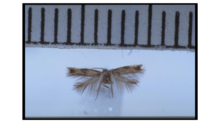Stigmella hamishella
| Stigmella hamishella | |
|---|---|

| |
| Male holotype | |
| Scientific classification | |
| Domain: | Eukaryota |
| Kingdom: | Animalia |
| Phylum: | Arthropoda |
| Class: | Insecta |
| Order: | Lepidoptera |
| Family: | Nepticulidae |
| Genus: | Stigmella |
| Species: | S. hamishella |
| Binomial name | |
| Stigmella hamishella Donner & Wilkinson, 1989[1] | |
Stigmella hamishella is a moth of the family Nepticulidae.[2] It is endemic to New Zealand and has been observed in the South Island. The larvae mine the leaves of Olearia moschata. The mine consists of blotches, mainly on the lower leaves. The preferred habitat of S. hamishella is the same as its host plant, montane to subalpine shrubland. Adults are on the wing in December.
Taxonomy
This species was first described in 1989 by Hans Donner and Christopher Wilkinson from specimens collected in Fiordland.[3] The male holotype specimen, collected at Homer Tunnel, at 900 m altitude on the 29 December 1983 by B. H. Patrick, is held in the New Zealand Arthropod Collection.[3]
Description
Donner and Wilkinson described the male of this species as follows:
Head. Frontal tuft white; scape white and grey; collar greyish white; antenna dark grey, comprising 36 segments. Thorax grey. Forewing about 4 mm long; ground colour whitish grey, with basal, medial, and terminal dark grey areas and vague black spots medially and terminally; fringe grey. Hindwing and fringe grey. Abdomen pale brown.[3]
Donner and Wilkinson described the female of the species as follows:
Generally larger than male; antenna comprising 32 segments; forewing paler, with spots more conspicuous.[3]
Donner and Wilkinson explained that the differences in genitalia and general appearance of this species indicated that is a discrete species.[3]
Distribution
This species is endemic to New Zealand.[1][4] It has been observed in the South Island.[3]
Host and habitat

The larvae feed on Olearia moschata.[5] The preferred habitat of S. hamishella is the same as its host plant, montane to subalpine shrubland.[3]
Behaviour
The larvae of this species mine the leaves of their host plant.[3] The mine consists of blotches, mainly on the lower leaves. Adults have been recorded in December.[3]
References
- ^ a b "Stigmella hamishella Donner & Wilkinson, 1989". biotanz.landcareresearch.co.nz. 8 October 2014. Retrieved 2023-10-06.
- ^ Erik J van Nieukerken; Camiel Doorenweerd; Robert J B Hoare; Donald R Davis (31 October 2016). "Revised classification and catalogue of global Nepticulidae and Opostegidae (Lepidoptera, Nepticuloidea)". ZooKeys. 628 (628): 65–246. doi:10.3897/ZOOKEYS.628.9799. ISSN 1313-2989. PMC 5126388. PMID 27917038. Wikidata Q28109648.
- ^ a b c d e f g h i Hans Donner; Christopher Wilkinson (28 April 1989). "Nepticulidae (Insecta: Lepidoptera)". Fauna of New Zealand. 16. Department of Scientific and Industrial Research: 23–24. doi:10.7931/J2/FNZ.16. ISSN 0111-5383. OCLC 924829916. Wikidata Q45079930.
- ^ Gordon, Dennis P., ed. (2010). New Zealand inventory of biodiversity: Kingdom animalia: chaetognatha, ecdysozoa, ichnofossils. Vol. 2. p. 461. ISBN 978-1-877257-93-3. OCLC 973607714. OL 25288394M. Wikidata Q45922947.
- ^ "PlantSynz - Invertebrate herbivore biodiversity assessment tool: Database". plant-synz.landcareresearch.co.nz. Retrieved 2018-07-12.
